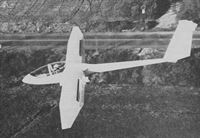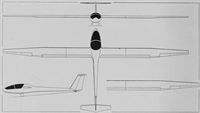
Варианты
- Caproni Vizzola - Calif - 1969 - Италия
- Rhein-Flugzeugbau (RFB) - Sirius - 1970 - Германия
M.Hardy. Gliders & Sailplanes of the world
Caproni Vizzola Calif A-21S
The Caproni company, formed in 1910, is Italy's oldest aircraft manufacturer and was best known for its bombers, such as the pioneer Ca 30 heavy bomber of 1913, and a line of 'Type Coloniale' bomber transports such as the Ca 133 used in the Italian African colonies. In recent years it has concentrated largely on subcontract work, but in 1969 began producing a series of Calif sailplanes designed by Carlo Ferrarin and Livio Sonzio; these were the A-10, of which one was built, the A-12 (two built), the A-14 (one built) and A-15 (one built) and the A-20; an improved two-seater version of the latter, designated A-20S, is now being developed. The original A-21, the prototype of which made its first flight on 23 November 1970, was a high performance two-seat version of the A-14, from which it differed in having a slightly longer fuselage widened to accommodate two in luxurious side-by-side seating. This version is now out of production and has been succeeded by the A-21S, which currently holds as many as four world records for two-seaters; among these is the current Class D2 speed record for women over a 300km closed circuit, set up on 18 August 1974 by Adele Orsi and Franca Bellingeri in an A-21S at a speed of 60.73mph. Over 100 A-21S Califs have so far been built, production of a third batch of 54 being ordered by January 1980, of which 29 had been delivered. The cantilever mid wings have a wide constant chord centre section and tapered trapezoid outer panels, and are all-metal; the three-piece all-metal main spar is supplemented by two auxiliary spars in the centre section and one in each outer panel, the downturned wing tips being of glassfibre. The trailing edge flaps/spoilers can act as air brakes when deflected to 89 downwards, and as camber-changing surfaces between ±8°; the plain ailerons are differentially-operated. The forward fuselage is a glassfibre/foam plastics semi-monocoque structure with a load-carrying light alloy frame, and the rear fuselage is a thin boom of all-metal stressed skin construction. The distinctive high aspect ratio fin and rudder is all-metal, and has the all-moving metal tailplane and elevator, which both have glassfibre tips, mounted on top; the tailplane trim is spring-adjusted. The mechanically-retractable twin main wheels have rubber-in-compression shock absorbers and a brake, and there is a fixed steerable tailwheel, as well as a small wheel in each downturned wing tip. The two pilots have dual controls under a rearward-sliding two-piece canopy, and sit in luxury seating equivalent to the best light plane standards.
Data: A-21S
Span: 66 ft 10 1/4 in
Length: 25 ft 4 1/2 in
Height: 5 ft 3 1/2 in
Wing area: 174.3 sqft
Aspect ratio: 25.65
Empty weight: 961 lb
Max weight: 1,419 lb
Max speed: 156 mph
Max aero-tow speed: 87 mph
Min sinking speed: 1.97 ft/sec at 53 mph
Best glide ratio: 43:1 at 65 mph
Caproni Vizzola Calif A-21SJ
The first powered version of the Caproni Vizzola Calif A-21 two-seater was fitted with a 202lb st Microturbo TRS 18 single-shaft turbojet of French design installed at the rear of the cockpit, and this version, known as the A-21J, first flew at the end of January 1972. In 1976 the sole prototype of the A-21J was acquired by the Lockheed-Georgia Co for use in a joint research programme with Mississippi State University. The J was succeeded by the A-21SJ, which first flew in May 1977 and is based on the current production A-21S sailplane; this is powered by a 1981 b st Microturbo TRS 18-046 turbojet aft of the cockpit, with a dorsal intake that can be closed in flight when soaring. Up to 242.5lb of fuel is carried in fuselage and wing tanks, and there is a starter/generator and batteries for in-flight and ground starting; this same engine also powers the Bede BD-5J jet lightplane. Apart from the engine the A-21SJ is very similar to the A-21S, but has larger mainwheels and tailwheel. Two A-21SJs had been completed by May 1979 and five more were being built. One A-21SJ was being tested with a more powerful Microturbo TRS 18 jet of 242.5 lbst.
Data: A-21SJ
Span: 66 ft 10 1/4 in
Length: 25 ft 4 1/2 in
Height: 5 ft 3 1/2 in
Wing area: 174.3 sqft
Aspect ratio: 25.65
Empty weight: 1,164 lb
Max weight: 1,781 lb
Max level speed: 143 mph (power on)
Max rate of climb: 787 ft/min (sea level, power on)
Take-off run: 985 ft (power on)
- M.Hardy. Gliders & Sailplanes of the world
Фотографии
-
Jane's All the World Aircraft 1974 / 03 - Sailplanes
Caproni Vizzola Calif A-15 single-seat high-performance sailplane
-
Jane's All the World Aircraft 1976 / 03 - Sailplanes
Caproni Vizzola Calif A-21 two-seat high-performance sailplane
-
Jane's All the World Aircraft 1974 / 03 - Sailplanes
Регистрационный номер: I-CCPV Caproni Vizzola Calif A-21 two-seat high-performance sailplane
-
Jane's All the World Aircraft 1972 / 03 - Sailplanes
Caproni Vizzola Calif A-21 two-seat high-performance sailplane
-
GL 1982- / M.Hardy - Gliders and Sailplanes /Gliders & Sailplanes of the world/ (1)
Caproni Vizzola Calif A-21S.
-
Jane's All the World Aircraft 1974 / 03 - Sailplanes
A-21J version of the Calif A-21, powered by a Sermel TRS 18 turbojet engine
-
Jane's All the World Aircraft 1976 / 03 - Sailplanes
A-21J version of the Calif, powered by a 202 Ib st Microturbo TRS 18 turbojet engine
-
GL 1982- / M.Hardy - Motor Gliders /Gliders & Sailplanes of the world/ (2)
Регистрационный номер: I-JETT [2] Caproni Vizzola Calif A-21SJ.
-
Jane's All the World Aircraft 1972 / 03 - Sailplanes
Caproni Vizzola Calif A-21J powered sailplane
-
Air Pictorial 1977-08 / J.Cook - Paris Report
Регистрационный номер: I-JETT [2] Caproni Vizzola A-21J Calif I-JETT with flag marking exhaust outlets
-
Jane's All the World Aircraft 1972 / 03 - Sailplanes
Caproni Vizzola Calif A-10 single-seat sailplane
-
Jane's All the World Aircraft 1972 / 03 - Sailplanes
Caproni Vizzola Calif A-20 side-by-side two-seat sailplane. Scrap view shows wing of A-21
- Фотографии











